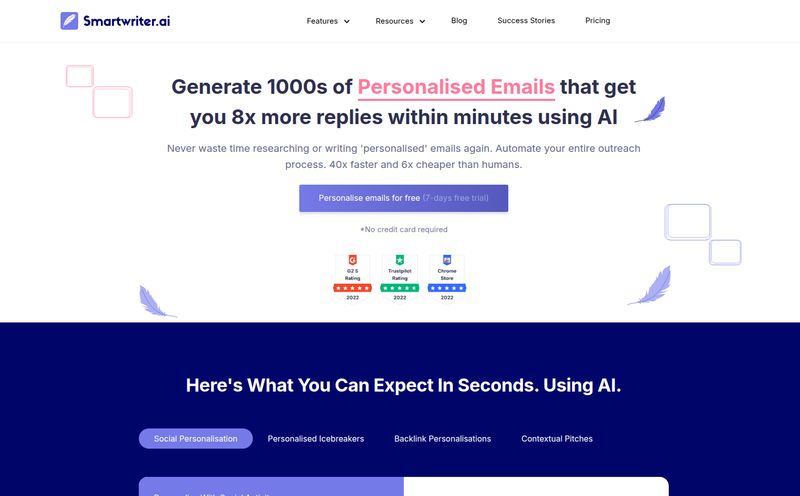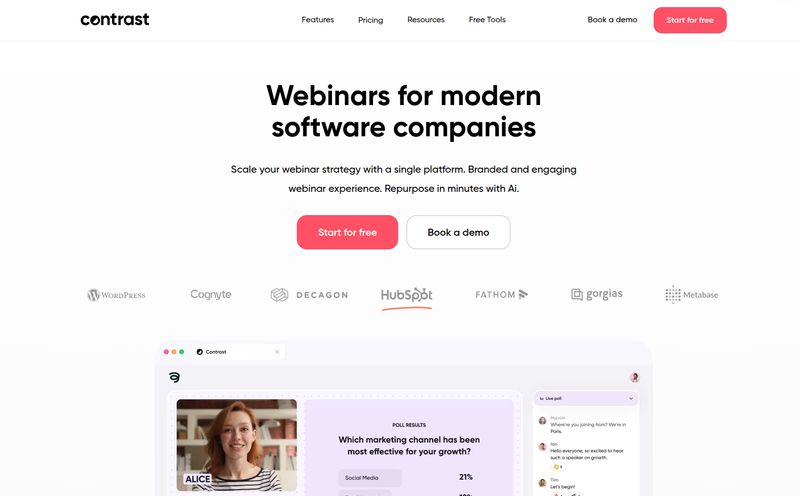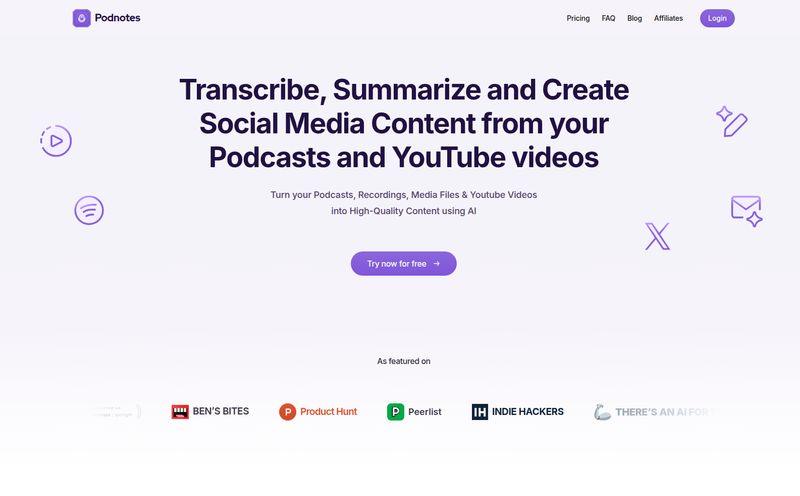Staring at a blank screen, trying to summon the perfect words for a cold email… it’s a special kind of marketing purgatory. You know the feeling. You write a line, delete it. Write another, feels too salesy. You finally hit send and then… crickets. It’s enough to make you want to throw your laptop out the window. I've been there more times than I care to admit.
In the last couple of years, AI has stormed onto the scene promising to be our savior. And while some tools are great, a lot of them just spit out generic, robotic-sounding copy that screams, “I was written by a machine!” It often lacks the nuance, the zing, that actually gets a human to reply.
So when a tool called Email Thunder popped up on my radar, claiming to be an AI copywriter specifically for high-converting cold emails and newsletters, my ears perked up. Another AI writer? Yawn. But one that’s specialized? Okay, now you have my attention.
So What is Email Thunder, Really?
At its heart, Email Thunder is an AI-powered platform designed to do one thing very well: write emails that get results. It's not trying to be a jack-of-all-trades AI that can write you a sonnet and then code a website. No, this is a specialist. Think of it less like a Swiss Army knife and more like a surgeon's scalpel, crafted specifically for the delicate operation of landing in a prospect's inbox and actually getting a response.
The whole idea is to take the guesswork and the sheer time-suck out of crafting outreach. It’s built for people who need to drive sales and engagement through email but don't have hours to agonize over every single word. Sound familiar?

Visit Email Thunder
The Features That Actually Matter
I’ve seen a million feature lists. Most are just fluff. Here’s the stuff in Email Thunder that genuinely made me nod and say, “Okay, that’s smart.”
Specialized AI for Cold Emails and Newsletters
This is the main event. They have two distinct AI writers. One is for cold emails—short, sharp, and focused on getting that first reply. The other is for newsletters, which is a completely different beast. A newsletter is about nurturing a relationship with an existing audience, not starting one from scratch. The fact that they've separated these functions shows they understand the game. You wouldn't use the same tone to ask for a meeting as you would to share your weekly insights, and your AI shouldn't either.
The Human Touch: 1-1 Coaching Calls
Okay, this is the part that really sets it apart for me. An AI tool that comes with access to 1-1 coaching calls? That's almost unheard of. This single feature tackles the biggest weakness of most AI platforms: the user. You can have the best tool in the world, but if you don't know how to use it—how to write good prompts, how to tweak the output—you're just wasting your money. Providing coaching is a massive vote of confidence in their own product and a genuine commitment to user success. It bridges the gap between technology and practical application. Frankly, more companies should do this.
A Community and Resource Hub
Email Thunder also includes community features, like voting on suggestions, and a curated list of recommended resources. This turns it from just a piece of software into more of an ecosystem. You’re not just buying a tool; you’re tapping into a network of other users and a library of useful sites and information. It's like getting a toolkit and a support group all in one package.
The Good, The Bad, and The Nitty-Gritty
No tool is perfect, right? Let's get into the brass tacks. I’ve always believed a good review is an honest one. So, here’s my breakdown of what I see as the major pros and some potential drawbacks.
On the upside, the time-saving aspect is a huge win. We're not talking about saving a few minutes here and there. We're talking about reclaiming potentially hours every week. That's more time for strategy, for calls, for actual selling. The quality of the copy, being tailored for outreach, is also a massive plus. It gives you a fantastic starting point that's already 80-90% of the way there, instead of a generic block of text. And as I've said, the personalized coaching is a game-changer.
Now, for the other side of the coin. It’s a subscription model, which is standard for SaaS but still a commitment. You’re paying for access, not a one-time purchase. Also, and this is true for any AI tool, its effectiveness hinges on two things: the quality of the AI and the quality of your input. It's not a magic button. You still need to provide a good prompt, understand your audience and offer, and then polish the output to make it your own. Some people might find there's a small learning curve to get the absolute best results, but honestly, with the coaching on offer, that feels like a pretty small hurdle.
What’s the Damage to the Wallet?
Alright, the all-important question: what does it cost? The pricing I saw listed was $6.99 per week. For that, you get the “Email Thunder +2 options” package. Now, what those “+2 options” are isn’t crystal clear from the get-go. This is where I strongly suggest you do your own due diligence.
My advice? Click over to their pricing page and see the absolute latest and most detailed breakdown. Things change, and it’s always best to get the info straight from the source.
But let's put that $6.99/week in perspective. That’s about the price of two fancy coffees. If this tool saves you even one hour of work a week, or lands you just one extra meeting a month, it's paid for itself dozens of times over. When you compare it to the cost of a freelance copywriter or the opportunity cost of sending bad emails, it starts to look like a pretty solid investment.
Is Email Thunder Right for You?
So, who should be clicking “buy” on this? In my opinion, Email Thunder is a fantastic fit for:
- Sales Development Reps (SDRs) and Sales Teams: Who need to send a high volume of personalized outreach without spending all day writing.
- Solo Founders and Entrepreneurs: You're wearing all the hats, and copywriter probably isn't your favorite one. This can be your secret weapon.
- Marketers and Agencies: Anyone managing newsletter campaigns or running lead generation for clients can get a huge efficiency boost.
- Content Creators: If you have a newsletter, this can help you beat writer's block and keep your content flowing.
Who might not need it? If you send maybe five cold emails a year, or if you have a dedicated, in-house team of copywriters, it might be overkill. This is a tool for people in the trenches, doing the work day-in and day-out.
In the end, Email Thunder seems to be a thoughtful, specialized tool in a sea of AI generalists. It's not just throwing technology at a problem; it's combining it with human support to solve a very specific, very common pain point for anyone in sales and marketing. For the cost of a weekly lunch, it feels like a low-risk experiment with a potentially massive upside.
Frequently Asked Questions
What makes Email Thunder different from just using ChatGPT?
The biggest difference is specialization and support. Email Thunder's AI models are specifically trained for cold email and newsletter formats, leading to more relevant output. Plus, the inclusion of 1-1 coaching and a resource community provides a level of support you won't get from a general AI tool.
Is Email Thunder good for someone new to cold emailing?
Yes, absolutely. In fact, it might be ideal. The combination of an AI assistant to handle the heavy lifting and coaching calls to teach you strategy can significantly shorten the learning curve and help you avoid common beginner mistakes.
How much does Email Thunder cost?
The pricing starts at $6.99 per week. However, it's always best to check their official pricing page for the most current plans and details, as offerings can change.
Can it guarantee high-converting emails?
No tool can guarantee results. Email Thunder provides a powerful AI to write excellent copy, but the success of your campaign also depends on your offer, the quality of your lead list, your sending reputation, and your own personalization. It's a powerful assistant, not a magic wand.
Do I need to be a tech expert to use it?
Not at all. It's designed to be user-friendly. While there might be a small learning curve to mastering the best prompts, the platform itself is straightforward, and the available coaching is there to help you get up to speed quickly.



